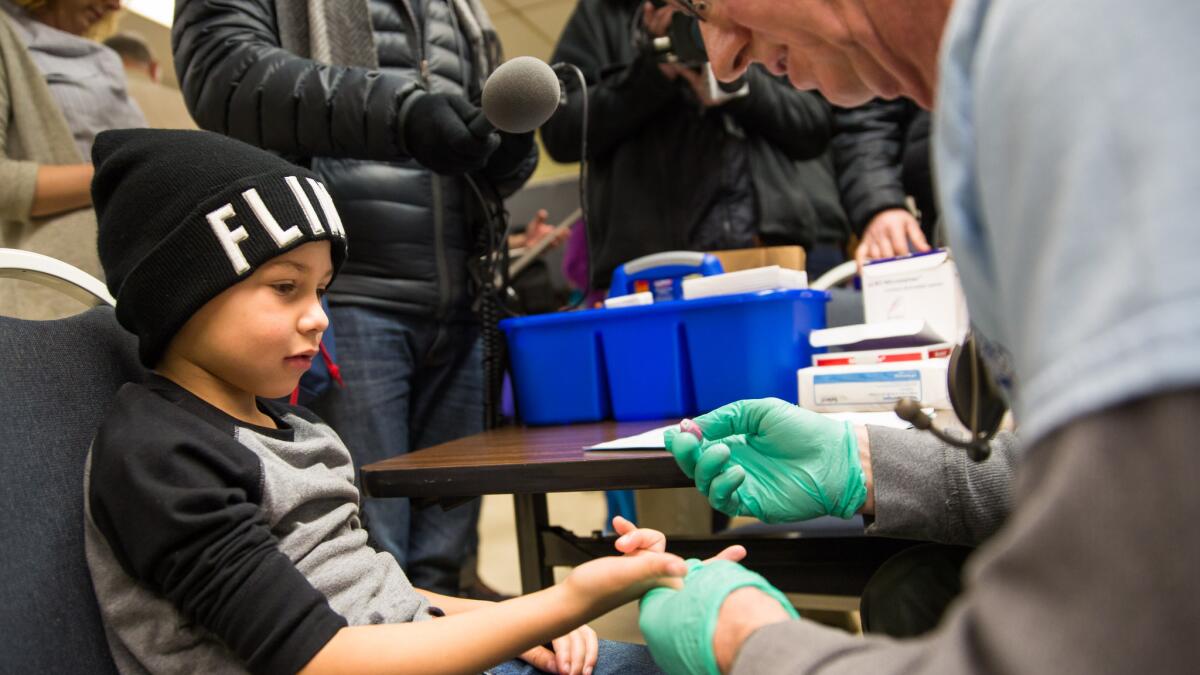Lead exposure soared after kids in Flint started drinking tainted water, CDC says

- Share via
After residents of Flint, Mich., started drinking water from the Flint River in April 2014, the chances that young children would have dangerous levels of lead in their blood increased by nearly 50%, according to a new report from the Centers for Disease Control and Prevention.
Researchers examined blood test results from more than 7,000 children that were collected around the time authorities decided to save money by sourcing Flint’s water from the Flint River instead of Lake Huron.
In Michigan, children living at or below the poverty line are targeted for lead screenings, and children enrolled in the state’s Medicaid program are required have their blood tested for lead around their first and second birthdays. High lead exposure, especially in children under 6, can slow growth, reduce intelligence and attentiveness, and cause behavioral problems.
Unfortunately, when Flint began using Flint River water in April 2014, officials did not employ any corrosion control measures at the water treatment plant. As a result, when the water flowed through old pipes and fixtures, lead was able to seep into the water supply.
In the year leading up to the change, 3.1% of Flint children ages 5 and under had blood lead levels exceeding the CDC limit of 5 micrograms per deciliter. Over the next 10 months — until the discovery of disinfectant compounds in the river prompted officials to issue a water advisory — that figure rose to 5%.
Kids between 1 and 2 years old had a higher risk of exceeding safe lead levels, and the odds of excess lead were greater during the summer and fall months. After adjusting for these and other factors, the researchers calculated that the switch to Flint River water was associated with a 46% increase in the odds that a child would have excess lead in their blood.
“This crisis was entirely preventable,” Patrick Breysse, director of CDC’s National Center for Environmental Health, said in a statement.
Although the advisory in January 2015 wasn’t related to lead, it prompted many residents to opt for bottled water over tap, therefore reducing their lead exposure. Over the next 9 1/2 months, 3.9% of children were found to have dangerous levels of lead in their blood.
In October 2015, the city of Flint switched its water source back to Lake Huron. Pregnant women and children under 6 were advised to drink bottled water, while the general population was told to drink filtered tap water.
In the five months after that, lead concentrations in children 5 and under dropped to 1.4%.
The findings were published Friday in the CDC’s Morbidity and Mortality Weekly Report.
On Thursday, the Environmental Protection Agency released a statement that it is now safe for everyone in Flint to drink filtered tap water.
“This is an important step forward for providing a stable water system for the city of Flint,” EPA Science Advisor Thomas Burke said.
More than 90% of Flint homes are now equipped with water filters.
Follow @mdaley_ on Twitter for more science news and “like” Los Angeles Times Science & Health on Facebook.
MORE IN SCIENCE:
From Duryea to Tesla, cars have evolved much like Darwin’s finches
Super-sticky saliva helps chameleons catch huge prey, scientists say
It’s been 20 years since Australia had a mass shooting. How much of the credit goes to gun control?






